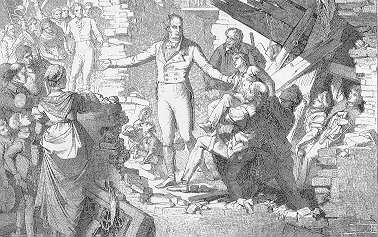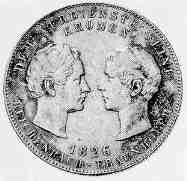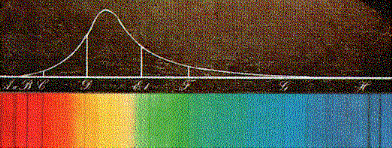

Dramatic representation of Fraunhofer's rescue Medallion struck in honor of
( A. Mueller, 1852) Fraunhofer and Reichenbach by
King Ludwig I
( extended
biography )
Josef Von Fraunhofer was the eleventh and last
child born to Franz Xaver Fraunhofer, a glass master worker, on March 6,
1787. His mother died when he was ten years old, and his father died a
year later. Since compulsory school attendance was not required in
Bavaria before 1802, the young boy was sent as an apprentice to the glass
master Weichselberger in Munich. Weichselberger was extremely demanding
of the youth and Fraunhofer was forbidden by the glass master to attend
the vacation schools ( 50 days of vacation per year in Bavaria at
the time). Of great importance to the development of Fraunhofer was a catastrophic
collapse of the two buildings that Weichselberger had rented in Munich
in July 1801. The boy was in the workshop at the time and buried in the
ruble. A dramatic rescue brought him into contact with Count Maximilian
IV ( later King Max I) and the entrepreneur Joseph Utzschneider. The Count
gave the youth the modern equivalent of 40000DM($30000) and took him under his
protection. In 1804 he used half of the money he had received from the
Count to purchase the remainder of his apprenticeship from Weichselberger,
and in 1806 Utzschneider brought him into his Optical Institute.
When Fraunhofer started working for Utzschneider he could scarcely perform the most simple arithmetic. Utzschneider purchased books on mathematics and optics for Fraunhofer, and the young man would study these as long as daylight allowed, or on his vacation days outside. He was largely self-taught. Fraunhofer was a significant addition to Utzschneider's company, inventing or perfecting industrial techniques.
Among Fraunhofer's achievements were the invention of the diffraction grating, a detailed study of the solar spectrum, and production of the finest telescopes available in his day.
Fraunhofer died on on June 7, 1826 after a year long bout with lung tuberculosis. His life was commemorated by a medal struck in his honor ( and Reichenbach) by King Ludwig I. The epitaph placed on his grave stone by Utzschneider read " Approximavit sidera " , " He brought the stars closer to us."


Dramatic representation of Fraunhofer's rescue
Medallion struck in honor of
( A. Mueller, 1852)
Fraunhofer and Reichenbach by
King Ludwig I

| angstroms | Line due to | |
| A | 7594 | Telluric oxygen |
| B | 6867 | Telluric oxygen |
| C | 6563 | hydrogen, H |
| D1 | 5896 | sodium |
| D2 | 5890 | sodium |
| D3 | 5876 | helium |
| E | 5270 | iron and calcium |
| b1 | 5184 | magnesium |
| F | 4861 | hydrogen, H |
| G | 4308 | iron (and calcium) |
| H | 3968 | calcium |
| K | 3934 | calcium |